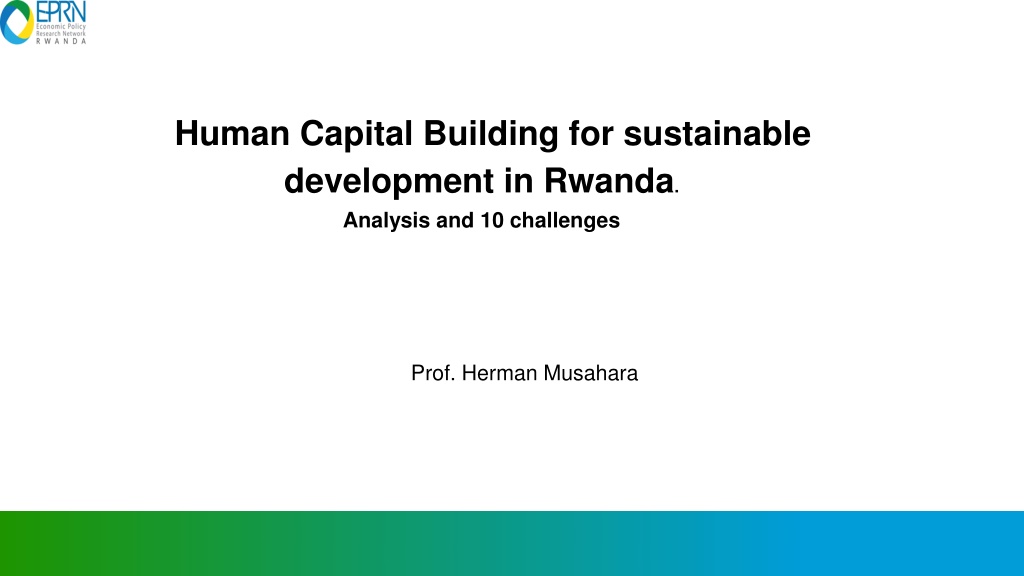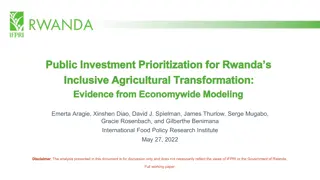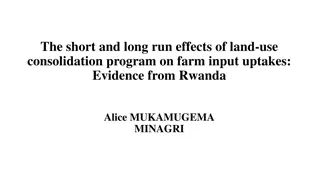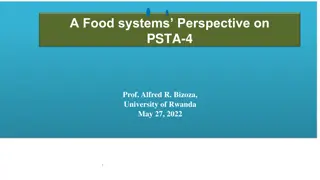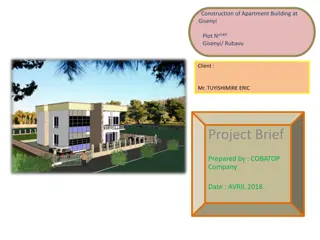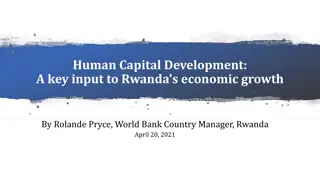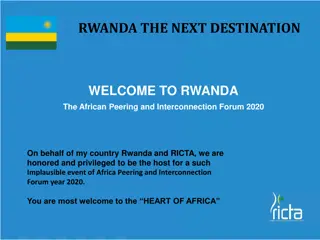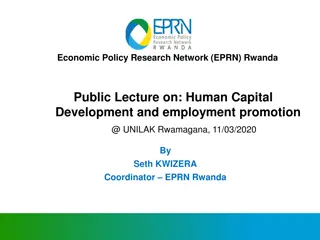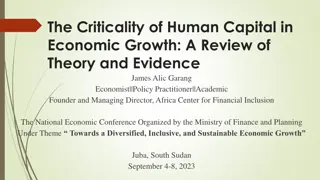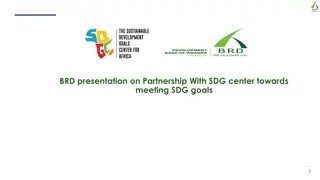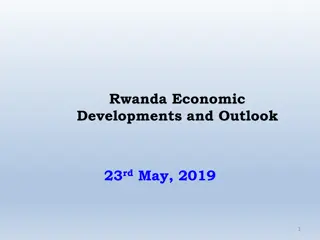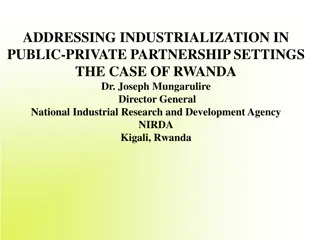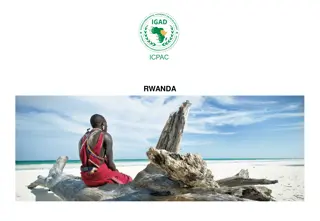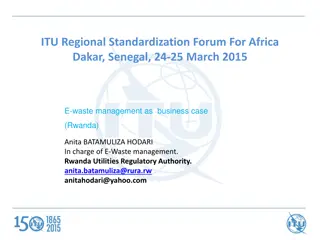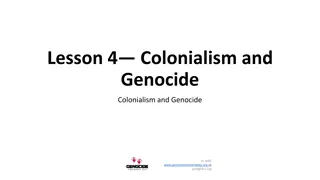Human Capital Building for Sustainable Development in Rwanda: Analysis and 10 Challenges by Prof. Herman Musahara
This analysis by Prof. Herman Musahara delves into the significance of human capital building for economic growth and development, especially in post-pandemic recovery periods. It highlights Rwanda's strides in human development post-genocide while noting existing challenges like child stunting and low human development index. The report emphasizes the need for a knowledge-based economy and improved policy formulation for sustainable development.
Download Presentation

Please find below an Image/Link to download the presentation.
The content on the website is provided AS IS for your information and personal use only. It may not be sold, licensed, or shared on other websites without obtaining consent from the author. Download presentation by click this link. If you encounter any issues during the download, it is possible that the publisher has removed the file from their server.
E N D
Presentation Transcript
Human Capital Building for sustainable development in Rwanda. Analysis and 10 challenges Prof. Herman Musahara
Key messages Objectives Meaning, conceptual frame and scope Rwandan context and questions Situation and gaps 10 Challenges Recommendations
Messages 1.Human capital building is key to economic growth and sustainable development especially in low income countries seeking transformation and periods of after shocks recovery from pandemics 2.Human capital building should not be truncated to education and health and workforce skills formation. Its multisectoral, multilevel and needs a long term perspective but which needs to be coordinated
3.Rwanda has performed extremely well in recovering from the effects of the Genocide against the Tutsi and human development and remarkable steps in building human capital have been taken 4.Rwanda is however still poor with worrying levels of children stunting and a low human development index. More miles needs to be covered 5.Building a knowledge based economy and transforming the economy of Rwanda and especially in the post COVID era needs new effort in policy formulation and implementation in sequencing and prioritizing drivers of sustainable development 4
Objectives To define concisely the meaning and scope of human capital building as it is referred to in policy discourses and strategies To elaborate the Rwandan context of human capital building and gaps that need to be addressed To analyse on the situation of major human capital building components in Rwanda and their evolution in Rwanda To summarise the major challenges that the human capacity building functions in Rwanda To make succinct recommendations on what policy response would be required and strategic in the current development trajectory and planning in Rwanda
Human capital refers to the economic value of an employees skills and experience. This count things like education, training, intelligence, health and even quality like loyalty and punctuality that offers value to an employer. Human Capital is an intangible asset. Tamplin 2020 Rich discourse since 1960s. Becker,Shultz Wide research World Bank ..etc Narrow or truncated approach ..at times focusing on area of interest,..workforce, education ,skills,children, corporate
Rwanda and capital availability and access..natural, financial, physical makes human capital a major priority Genocide Against Tutsi effects and implications to human capital 1 in 7 dead and 1 in 3 displaced in 1994 Rwanda economic recovery path and place of human capital ..Vision 2020,EDPRS 1 and 2, NST,SDGs and Vision 2050 COVID 19 and global shocks
Questions That 29 years after a collapse of the economy Rwanda is among the most competitive countries in Africa has meant a lot was done in terms of human capital building. What was done and what have been the outcomes? But Rwanda is still a poor country what needs to be done involving human capital in the next 25 years,100 years .. Do we have a long term perspective of human capital building? Which are the best policy opportunities to stimulate rapid economic growth from the human capital perspective?
. Questions Rapid economic growth leveraging human capital formation is not enough. Which human capital building interventions can lead to less or zero poverty, more gender sensitive, greener interventions and decent livelihoods? The economy like many others has been affected by the COVID 19 pandemic. How can human capital building assist the economy to recover in the short and long run? Does it get the right prioritization in its entirety? What about resources mobilization and allocation? 10
3.Situation 1. Remarkable human capital formation 1994 to 2022 2. Notable advance in education and skills formation 3. Improved health and quality of life 4. Population a growth and possibility of a potential demographic dividend 5. Still low on human capital index 6. Budget constraints on key sectors 7. Policies and institutions have been put in place to boost human capital building 8. COVID 19 disrupted a healthy development trajectory with long term implications to human capital
4.Challenges Of crucial importance is not the quantities of human capital that are invested in but also the quality, the specific soft attributes that lead more to economic growth that is higher and more equitable. 1. Education is still a vast sector with different levels all requiring resources and infrastructure for development. The quality and relevance of the education system is still an area that needs constant attention and resources as well as a long term view of transforming Rwanda. 2. Resource needs to the health sector have become higher following the global COVID pandemic and the need to ensure a demographic dividend from the next generation. 3. There is still child poverty and the rate of stunting though reduced are still substantially high. The quality of population trends need to be sustained for harnessing the demographic dividend 4.
5. The human capital index is still relatively low despite achievements in human capital building in the past 6.Despite education having the best share of public expenditure it still has the challenge of being the major villain of human capital development with financing gaps not only for quantities at various levels but also the quality and relevance of learning in relation to skills for transformation. Health is trailing behind but it will however be noticed that because after 2020 the public expenditure spiked and more will be needed for mitigation of pandemics and development of vaccines. A major challenge to human capital development remains fiscal space. Innovative financing mechanisms including all stakeholders need to be devised. 7.Policy making and implementation is crucial to human capacity building. Monitoring and measuring of impact are still needed. Advocacy and dialogue need updated evidence to be of use to stakeholders. Gaps have been expanded by COVID and post COVID crises
. 8.Long term growth is likely to be significantly lower than pre COVID trajectory unless there are some policy interventions. It is projected that effects are to be felt for years and GDP by 2030 would be 22 % lower than a baseline set in 2021 in recovery planning. 9.Human capital building for sustainable development should include environment and mitigation of climate change effects. Environment 10.Gaps in access and application of ICT for human capital building by a large majority of the populations.technology 14
Indicators of situation and challenges Human development Changes in components 1994 2022 Year Human development index 0.341 2000 Economic growth per cent Life expectancy in years Mortality rate pr 1000 GDP per capita $ Literacy rate % -50.25 9.4 2005 0.413 21.8 69.1 2010 0.492 2015 0.526 196.3 26.5 2016 0.527 127 818 2017 0.535 2018 0.540 57.85 7 2019 0.543
Education 2002 2012 2022 Primary school enrolment for example has taken the biggest share of the sector with 2,512,465 in 2019 or 69.1 % and rising No education 33.5 25.5 22.2 Higher Education and adult literacy enrolment have been persistently decreasing between 2017 and 2019. In 2017 higher education enrolemnet was 80,773 and declined to 72,128 in 2019 while adult literacy was 152,015 in 2017 and declined to 127,117 in 2019. Primary 58.8 56.7 53.9 Secondary 5.0 10.8 15.1 Higher education includes TVET education level ,6 and 7 and secondary education. University 8.5 1.9 3.3 Moreover it has been noted that the gross secondary enrolment of 43%(2019) lower than regional average of 50% but higher than income group 42%. Primary 6- 11 Secondary 12-17 Adolescent girls out of school is 8% ( 2018) is much better being lower than the regional average of 33% and of the income group 40%. Gross Attendanc e Net Attendanc e 141.7 39.9 Major issue is quality of education and fit with the labour market and strategies 89.3 22.3
Health indicators Year Under 5 IM Neonatal Health improvement is key to quality of labour and the prospects of a demographic dividend A notable situational improvement is life expectancy in Rwanda Rwanda is the first in the region in the average number of years one expects to live on birth. In 2000 The life expectancy was estimated to be about 47.5 years while it is now more than 69 Most indicators in the health sector that feed in the life expectancy at birth have improved In a country of 13.2 million people and 26,338 sq.kms 75% of Rwandans being in about 5 km to a health facility(5th PHS) But there are challenges of diseases, pandemics and resources in planning fro recovery and long term human capital building 2014/15 50 32 20 2019/20 45 33 19 Number Referral hospitals 8 Provincial 4 Districts 42 Health centres 500 Dispensaries 1700
Population trends Year Population Density Year Rate 2007/08 5.5 2002 8,128,513 321 2010 4.6 2012 10,515,973 415 2014/15 4.2 2019/20 4.1 2022 13,246,394 503 Year Expectancy of life at birth 2032 16,396,633 623 1978 46.4 1991 53.7 2042 19,396,633 759 2002 51.2 2012 64.5 2053 23,558,616 894 2022 69.6
Boys Girls Overall HCI 0.37 0.39 0.38 Human Capital index Survival to age 5 0.96 0.97 0.96 . It measures the amount of human capital a child born today expect to attain by age of 18. It conveys the productivity of the next generation of workers compared to a benchmark of complete education and full health. In 2020 globally a child born on average is expected to be 56 % as productive as she could be when she grows up. A child born in Rwanda today will be 38% as productive when she grows up as she could be if she enjoyed completed education and full health. Expected years of school 6.6 7.1 6.9 Harmonize d Test Score 351 365 358 Learning adjusted years of school 3.7 4.1 3.9 Adult survival rate 0.79 0.84 0.81
2018/ 18 2019/ 20 2020/ 21 2021/ 22 2022/ 23 Budget allocation Educ ation 278.2 313.4 487.1 479.1 573.5 To be noted is that more than half the budget of education is allocated to pre primary and primary education. The per cent share of major sectors in the budget 2022/2023 are as follows; Public Finance Management 36.9%,Education 12.3,JRLO 9.3,Health 7.8,Transport 5.8,Energy 5.0,Agriculture 3.6 an Environment 2.1. P ublic spending on health 4.2 % (2017 ) better than the regional average of 2.4% and income group 2.1%. Education expenditure took 3.1 % of GDP (2018) lower than regional average of 4.0% and for income group of 3.6%. Healt h 232.4 245.4 282.3 441.4 365.2 WAS H 48.4 45.5 42.1 55.7 78.3 SP 141.1 149 173.1 145.5 172.3
Policy PRSP ,Vision 2020,EDPRS, had human resource development as priority .Organizations and programmes to help with human capital development over years have been put in place; HIDA, PSCBS, RDB etc UN ,INGOs Universities and Research networks participate in human capital building. New challenges arising from problems of pandemics like COVID 19 and climate change effects need skills in addressing them Technology access and skills are important in building human capita today. Infrastructure and resources need to be planned for including use of AI There is need to link academia and industry; and ensure all grtafduates master IT and have emough prcatical skills required onn the market
The overall recommendation is addressing each of the questions posed and each of the challenges proposed. There are multiple stakeholders in government UN development partners and Civil Society who contribute variously to the human capital building effort in Rwanda. There is a need for a comprehensive coordination mechanism to implement and monitor human capital building holistically Mechanisms of mobilizing resources including the private sector need to be put in place.
Measuring and monitoring human capital building and policy response and implementation needs to be accelerated Data, modeling as well as micro and macro level evidence collection and dissemination for policy action assist in making sure both short and long term scenarios for which human capital building is strong are articulated and planning uncertainties reduced Advocacy and dialogue on human capital building and prioritization as well sequencing of interventions among different areas is important especially among non governmental actors
